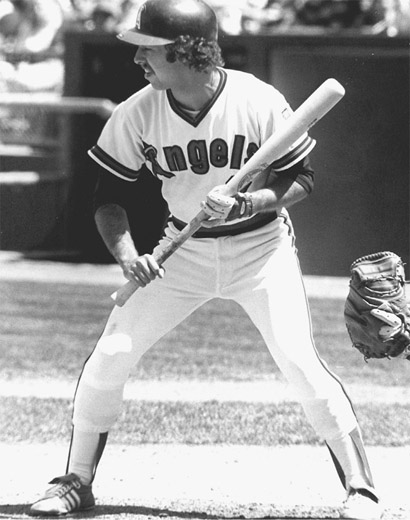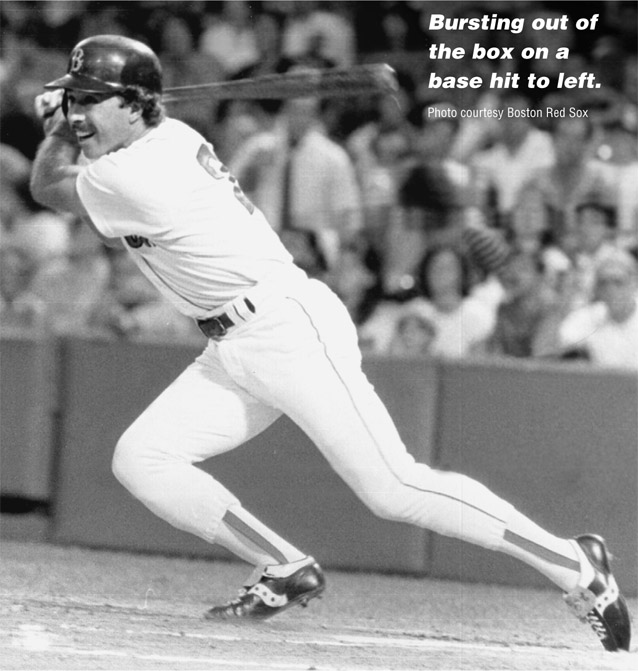

Looks like I just faked a bunt to see which way the infielders are going to be moving. If I got a reaction that I liked, I would probably try to bunt for real on the next pitch.
Photo courtesy Los Angeles Angels of Anaheim Baseball Club
C H A P T E R N I N E
Being a pinch hitter is the most difficult offensive job. This player has to go from sitting on his tail for most of the game to coming up to the plate at a pivotal moment. I have seen some pinch hitters whose natural instinct is to go up and whack the first good pitch they see. Other guys are more patient and work the count.
A good pinch hitter is a key member of the team. This is a guy who can start a rally, keep one going, or provide the big hit to take the lead. It takes a special temperament for this job. Ted Williams could have been a lousy pinch hitter. You cannot merely say, “This guy is a career .350 batter so he should make a good pinch hitter.”
Remy Says: Watch This
Go Figure
Bobby Kielty batted .218 in 2007, with a total of 87 at bats split between Oakland and Boston. As a pinch hitter, he was 0 for 33 for the season, and for his entire career he had 53 regular-season home runs—about one every 34 at bats.
And though he had recorded a few hits here and there against Colorado pitching in interleague play, he was 0 for 2 against reliever Brian Fuentes. So, of course, the following happened in the eighth inning of the final game of the 2007 World Series: Sent up to the plate as a pinch hitter for Mike Timlin with the Red Sox clinging to precarious 3–1 lead, Kielty swung at the first pitch he saw and sent it over the leftfield wall. The run turned out to be the winning margin in the 4–3 clincher.

In the American League, you usually don’t see a pinch hitter until late in the game. In the National League, managers may use a pinch hitter to bat for the pitcher earlier in the game. Sometimes the manager is able to give a little bit of advance notice. He might tell the pinch hitter that if a certain situation happens, he will be hitting for the second guy up in the next inning. In that case the player might go into the clubhouse and stretch, perhaps run a bit to get some blood flowing.
But often he will have almost no warning at all; there may be two outs and someone gets on base in scoring position and the manager decides to bat for the next man in the lineup. The pinch hitter is placed into the most important moment of the game and he doesn’t even have a sweat going.
The designated hitter (DH)—a position in the American League only—is also a difficult assignment for many athletes who made it to the major leagues on the basis of their overall ability as a ballplayer. Such a player is accustomed to having his plate appearance and then taking his spot in the field; when he is in the field he is concentrating on defense. For most players baseball is similar to football in that they know that if they screw up one play, they’ll get a chance to make the next one right. But if they’re the DH and all they are doing is hitting, that’s the only thing on their mind until their next at bat. Some guys adjust very well, but other guys hate it because they don’t get a chance to go out in the field.
A single at bat might last a minute or a minute and a half, and the DH might not get up again for another forty-five minutes. So he might be involved for seven or eight minutes out of a three-hour game.
Some DHs sit on the bench, but most go to the clubhouse to watch the game on television and videotapes of their last at bat. Some will swing at tape balls, ride a bike, and do anything to stay loose. Then they need to get back out to the bench a few minutes before they’re due up; it takes a few minutes for eyes to adjust to the light, especially in a night game.
Remy’s Top Dawgs
One of the best pinch hitters in the history of the American League was Joe Cronin, whose number 4 is one of five retired by the Red Sox (along with Ted Williams 9, Bobby Doerr 1, Carl Yastrzemski 8, and Carlton Fisk 27).
As a player-manager he seemed to know when to put himself into the game: He still holds the American League record for most pinch-hit home runs in a season with five, and the most pinch-hit RBIs in a season with twenty-five. Both marks were made in 1943.
He also became the first player to hit pinch-hit home runs in both games of a doubleheader, on June 17, 1943, in a stretch when he hit three 3-run pinch-hit homers in four at bats.
Going into the ninth inning with a lead, a manager might bring in a weaker-hitting defensive replacement in hopes of improving the team’s chances on the field. (Or he might take a star hitter out of the lineup to insert a pinch runner late in the game, but he’d try not to do that if he thought the hitter might have a chance to come up to the plate one more time.)
It could backfire if somehow the game gets tied and the defensive player has to come to the plate. But in close games managers will generally go for their best defensive team in the field in hopes of picking up an out they would not have otherwise gotten. If the game goes to extra innings, well you have to go with the lineup you have.
Remy’s Top Dawgs
David Ortiz was the best designated hitter in baseball in 2005 and again in 2006. In 2005 he batted .300 for the season with 47 home runs and 148 RBIs, almost all as the DH. He appeared at first base for all or part of just ten games, mostly against National League teams when the DH rule did not apply.
In 2006 his batting average and RBIs declined slightly, to .287 and 137, but his home run total went up to 54, setting a new Boston Red Sox record for long balls, eclipsing the previous record of 50 set by Jimmie Foxx. He was also responsible for five walk-off base hits (including three home runs) during the season.
For 2007 Ortiz saw his power numbers decline a bit, but he was still a force to be reckoned with in the Red Sox lineup. He posted the highest batting average of his career, at .332. But his home run and RBI numbers were “only” 35 and 117. He had the most hits of any season in his career, with 182, and the most doubles, with 52. Big Papi battled problems with his right knee and his shoulder, and Manny Ramírez’s very slow start to the season might have allowed some opposing pitchers to work around Ortiz . . . just a little bit.
Since the inception of the DH rule in 1973, the Red Sox have had a few of the best designated hitters. Orlando (Cha Cha) Cepeda won the Associated Press Outstanding DH Award in 1973, batting .289 with 20 home runs and 86 runs batted in, at age thirty-five. He came over from the Atlanta Braves in the National League and never took the field again, appearing in 142 games as a DH in 1973 and 26 games in 1974 for Kansas City before retiring.
Jim Rice won the AP award in 1977, batting .320 with 39 home runs and 114 runs batted in. That year, he played 116 games at DH and 44 in the outfield. And Don Baylor won in 1986, batting just .238, but hitting 31 home runs and driving in 94 runs at age thirty-seven.
“How can you hit and think at the same time?”
YOGI BERRA
I hate to see managers second-guessed when they make a substitution because most of the time they are doing the right thing. The manager is trying to get the best players on the field at the right time. If the team can’t hold the lead, it is probably not going to be the manager’s fault.
There are some players who almost never take batting practice. And there are great hitters who will be out there every day. I remember seeing Ken Griffey Jr. taking extra batting practice every day before the rest of the team started batting practice, and then he would take his normal turn with them.
A player can get as much batting practice as he wants, including live batting practice with somebody throwing to him, or flips in the batting cage. Some batters hit off a tee, trying to perfect certain things in their swing. Other guys prefer to have the ball flipped to them because it is moving toward them like a regular pitch.
If the team is on the road, the regularly scheduled time for batting practice for that night’s game might be 5:30 p.m. But there will be guys out on the field at 3:00 who want to get in some extra swings. Most teams will work with the visitors to make the field available. At home it’s your home park and you can pretty much do what you want.
All the new stadiums—and many old ones like Fenway Park—have indoor cages. So even if there’s a rainout, there are ways to take some batting practice. In many of the newer ballparks, the cages are just steps from the dugout or the clubhouse. Some designated hitters or pinch hitters go into the indoor cages in the middle of the game.